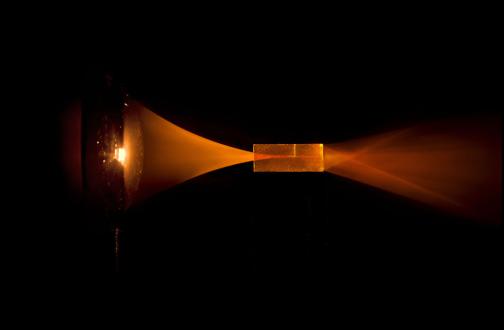Otago collaborates in breakthrough for quantum hard drive
Otago collaborates in breakthrough for quantum hard drive
Friday 9 January 2015
A team of Australian and New Zealand physicists have extended the storage time for a prototype quantum super-computer optical hard drive by over one hundred times.
Scientists at the Australian National University (ANU) and the University of Otago have achieved a major breakthrough, reported in Nature this week, demonstrating six-hour quantum storage using atoms of the rare earth element europium embedded in a crystal.
It has long been hoped that scientists will eventually come up with a way to store data in a state of quantum entanglement for the benefit of ultra-secure communications.
However, at present, such states can only be maintained for a short time before the entanglement fails. The Australian and New Zealand research team has come up with a way to store data for hours, rather than milliseconds. This new breakthrough heralds the world’s first solid state quantum hard drive.
“Quantum states are very fragile and normally collapse in milliseconds. The fact that we have storage times of hourshas the potential to revolutionise how we distribute quantum entanglement in a communication network,” says lead author Ms Manjin Zhong, from the Research School of Physics and Engineering at the ANU.
Utilising this effect, a quantum communication network could be used for perfectly secure encryption for data transmission.
“Our experiment shows that it is now possible to think of extending the range of quantum communication by storing entangled light in separate memories and then transporting them to different parts of the network,” Ms Zhong said.
The team essentially created the ROM by embedding an atom of the rare-earth element of europium into a crystal matrix.
After writing a quantum state onto the nuclear spin of the europium using light, the team subjected the crystal to a combination of a fixed and oscillating magnetic fields to lock the atom’s spin in place and preserve the fragile quantum information.
“This prevented the quantum information leaking away for as long as six hours, which is quite surprising,” says Dr Jevon Longdell from the Dodd Walls Centre for Photonic and Quantum Technologies at the University of Otago.
“Our goal is to extend this storage time out past a day. Once we reach this target we believe it will be possible to physically distribute entangled quantum states between any two points on the globe.”
Current quantum communication networks are limited to distances of about 100km.
“You can distrubute the entangled pairs of quantum states literally in a box sent via the post. Then use these entangled pairs to come up with a shared secret key and then use this secret key to do the communication. By comparing the results with your friend you can come up with a secret that only you two share. The neat thing is that we have discovered you can do this comparison without a secure channel,” he says.
“In the old days posting out secure keys was a routine thing to do. From a security point of view it wasn't great because it involved trusting the courier. This isn't something that our "quantum post" would suffer from. If someone tried to look what was in the crystal while it was in transit we would notice because they can’t measure the quantum states without disturbing them.”
Dr Longdell says that in the future scientists hope there will be quantum or super-fast computers that can solve difficult problems which current computers cannot solve.
“Our long term storage of quantum states would be helpful to achieve this,” he says.
The team is also excited about the fundamental tests of quantum mechanics that a quantum optical hard drive will enable.
"We have never before had the possibility to explore quantum entanglement over such long distances," said Associate Professor Matthew Sellars, leader of the research team.
“We should always be looking to test whether our theories match up with reality. Maybe in this new regime our theory of quantum mechanics breaks.”
The ANU’s
quantum storage crystal interacting with laser light.
Credit: Solid State Spectroscopy group,
ANU



 GNS Science: Bioshields Could Help Slow Tsunami Flow
GNS Science: Bioshields Could Help Slow Tsunami Flow Transport and Infrastructure Committee: Inquiry Into Ports And The Maritime Sector Opened
Transport and Infrastructure Committee: Inquiry Into Ports And The Maritime Sector Opened Netsafe: Netsafe And Chorus Power Up Online Safety For Older Adults
Netsafe: Netsafe And Chorus Power Up Online Safety For Older Adults RBNZ: 10 Cent Coin With King Charles III Image Now In Production
RBNZ: 10 Cent Coin With King Charles III Image Now In Production NZALPA: Safety Improves From AKL Incident Learnings
NZALPA: Safety Improves From AKL Incident Learnings NIWA: Antarctic Footprint Clean-up Challenges - How A Remote Antarctic Base Clean-up Protected One Of Earth’s Clearest Lakes
NIWA: Antarctic Footprint Clean-up Challenges - How A Remote Antarctic Base Clean-up Protected One Of Earth’s Clearest Lakes


